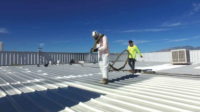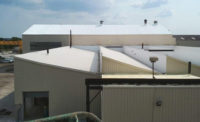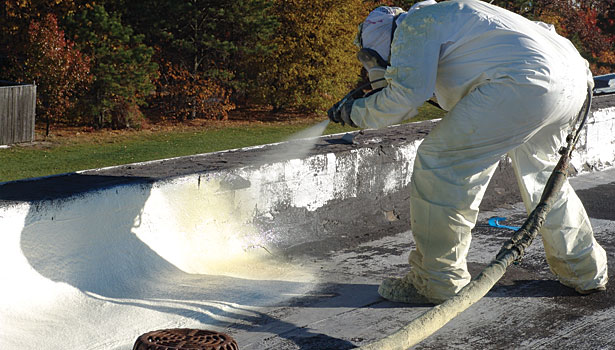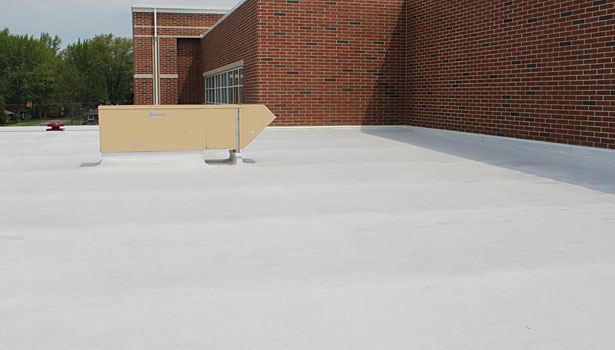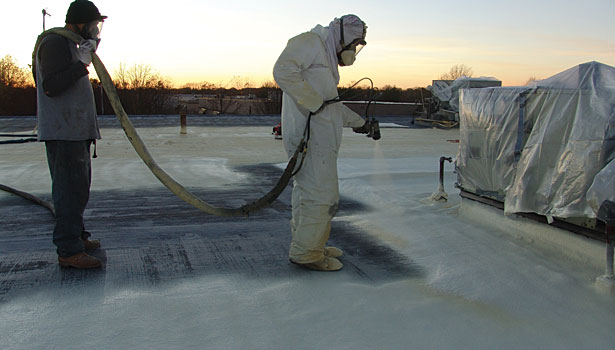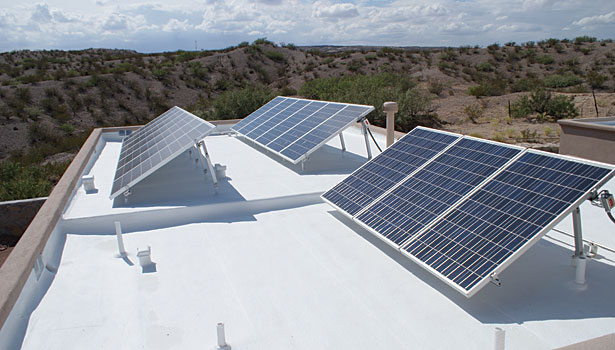Proper Installation of Spray Foam
Optimizing The Efficacy And Energy Efficiency Of SPF In Roofing Applications




Safety training and proper use of personal protective equipment is essential for all members of field crews. Photos courtesy of the Spray Polyurethane Foam Alliance.



Spray foam is lightweight, seamless, self-flashing, and highly resistant to adverse weather, wind uplift and foot traffic.







Spray polyurethane foam (SPF) is widely recognized as a highly effective building envelope material, with roofing systems being one of two core application categories (the second being building envelope insulation for walls, ceilings and floors). A high-performance product with many exceptional benefits, spray foam has gained market share with wide adoption by builders and roofing contractors. Like many building products, proper installation should always be performed by a professional installer utilizing proper handling and installation techniques, with safety precautions employed and followed.
In roofing systems, the foam serves dual purposes as a protective roofing material and as a thermal insulation solution.
A roof’s main purpose is to protect what is underneath it. SPF roofing systems provide durable protection for the structure below. Spray foam is lightweight, as most SPF roof systems weigh less than a pound per square foot when installed. SPF is also seamless and self-flashing, and highly resistant to adverse weather, wind uplift and foot traffic. Once installed, it requires minimal maintenance, providing increased strength to the roof. It performs well across all geographic regions and climates.
SPF also provides superb capabilities as both an air and water barrier. Not only does it protect against water and moisture intrusion, but it also reduces air movement through the roof system, improving indoor air quality and lowering the energy use of the building.
Because the roof of any structure is often a major source of heat loss, the insulating qualities of the SPF provide superb indoor temperature control and energy efficiency. As a thermal insulator, the foam has one of the highest R-values per inch of all roofing insulations; because spray foam is fully adhered, there are no thermal shunts from fasteners. Keeping warmth in the building during colder months and heat out in hotter months, the foam reduces heating and air conditioning demands, lowering energy costs for the life of the product, which independent studies cite at approximately 50 years or more with proper maintenance. In hot climates, reflective roof coatings may also be applied over the SPF to further reduce cooling costs.
Roof performance is not measured by one factor alone (such as R-value). Rather, the success of the roof system is properly assessed by reviewing combined considerations for air movement, moisture control, health, safety, durability, occupant comfort and energy efficiency — with SPF scoring high marks in each category.
Proper Spray Foam Installation Techniques
While the benefits of SPF are immense, they are optimized with the safe and proper installation of the product. Because SPF is essentially formed onsite during the installation, there are specific guidelines, techniques and measures that need to be taken to realize product performance and safety.
- Equipment care. The care of professional SPF installation equipment is imperative to ensure safety, proper installation and the optimum performance of SPF. Equipment should be regularly inspected, cleaned and repaired. Proper storage and maintenance of all equipment is critical to keeping the equipment in running order. Contractors should have a supply of spare parts in each rig to minimize downtime should equipment failure occur during foam installation.
- Proper storage. Spray foam chemicals must always be stored within the manufacturer’s suggested temperature range. Storing product outside of these temperature parameters can lead to reduced shelf life, making the product difficult to apply correctly. During installation, proportioners should be set to the manufacturer-recommended temperatures and pressures to produce ideal SPF.
- Safety precautions and attire. Spray polyurethane foam is formed on the jobsite by mixing equal volumes of two liquid components, known as the “A-side” and “B-side.” The A-side contains polymeric isocyanates, or pMDI. The B-side consists of proprietary blends of polyols, blowing agents, catalysts, fire retardants and surfactants. Manufacturers provide sets of A-component and B-component, typically in 55-gallon drums.
Chemical vapors and aerosols developed during application and for short periods thereafter must be considered. Appropriate protective measures must be employed to minimize risks associated with overexposure through inhalation or skin and eye contact. These measures include adequate ventilation during installation, safety training for all those involved in installation, use of personal protective equipment (PPE) and a medical surveillance program for field crews. PPE for chemical protection includes a full body suit and headsock covering the skin, along with nitrile gloves and eye protection. Respiratory protection for roofing includes an air purifying respirator (APR) with organic vapor cartridges (unlike interior, or confined space installation, which requires the use of supplied air respirators [SAR]). In accordance with OSHA, all roofing contractors must employ proper fall protection devices and methods.
Additionally, overspray from SPF roofing applications must be controlled to prevent it getting on unintended surfaces. Wind conditions may necessitate the use of wind screens (typically fabricated using frames of PVC pipe or lightweight wood and plastic screening). Strong winds may require the suspension of work until more favorable conditions prevail. Helpers in the vicinity of spray foam applications (such as wind screen holders and hose pullers) need to wear appropriate PPE.
- Surface evaluation. SPF has excellent adhesion to a variety of substrates including BUR, clay and concrete tile, shingles, metal, wood and concrete. Existing roof surfaces must be dry and free of oils, grease, dirt and debris that could affect adhesion. Since it adds little weight and can be applied in varying thickness to add slope and fill in low areas, spray foam roofing systems are often used as re-cover systems over existing roofs and are recognized for this use by the NRCA Weatherproofing Guidelines.
It is also important to assess weather conditions when applying spray foam. As with other roofing systems, the product may be applied in a wide variety of climatic conditions, however it is important to follow the manufacturer’s recommendations. The spray foam and protective coating should not be installed when there is ice, frost, surface moisture or visible dampness present on the surface to be covered. SPFA has published a guidance document on how to evaluate an existing roof prior to SPF application titled AY-138 “Guideline for Roof Assembly Evaluation for Spray Polyurethane Foam (SPF) Roof System” available as a free download from the Technical page of the SPFA website (www.sprayfoam.org).
- Selection of appropriate products. A wide range of polyurethane foam products is available in various densities and reactivity, each exhibiting different performance characteristics such as temperature limitations and compressive strength. Selection of the foam also affects installation characteristics, including the maximum lift thickness per pass, allowable substrate temperatures, etc., that in turn affect foam performance. SPFA publishes a guidance document, AY-104 “Spray Polyurethane Foam Systems for New and Remedial Roofing,” to assist in the selection of a specific roofing foam product.
- Preparation and priming. In many SPF roof system installations, priming of the substrate surface is required. Primers can greatly enhance adhesion between the SPF and existing substrates and roofing systems, or between SPF and existing layers of scarified foam, or between new SPF and protective coatings. Primers can help seal porous substrates, inhibit corrosion of metal substrates, and darken the substrates to increase solar heat gain (surface temperatures) and remove moisture. SPFA has published a guidance document on selection and use of primers for SPF roof systems, AY-143 “Primers: Why, When and How to Use Them.”
- Installation of protective coatings and coverings. Coating selection is dependent on climate and expected weather loads such as wind, rain, hail and solar exposure, as well as the durability and maintenance schedule for the roof system. AY-102 “A Guide for Selection of Elastomeric Protective Coatings Over Sprayed Polyurethane Foam” can help to select the proper coating for SPF roof systems.
Spray foam roofs may also be finished with aggregate, either loosely applied to the cured spray foam surface or embedded into wet coating. AY-110 “Spray Polyurethane Foam Aggregate Systems for New and Remedial Roofing” provides guidelines for the use of aggregate as a protective covering system.
All of the installation considerations listed here represent basic and essential practices for the installation of SPF for roofing applications. The best way to ensure these procedures and guidelines are followed is to utilize a professional and experienced SPF contractor. The Spray Polyurethane Foam Alliance Professional Certification Program (PCP) is also available to all professionals involved in SPF installation and allows contractors to demonstrate their knowledge, skills and abilities. The number of certified installers is rapidly growing throughout the country and represents the industry’s leadership in spray foam installation and safety practices. Proper installation techniques can optimize the product’s reputation as a premium building envelope solution, improve safety and lead to the overall success of the projects that rely on this high-performance technology.
Looking for a reprint of this article?
From high-res PDFs to custom plaques, order your copy today!



